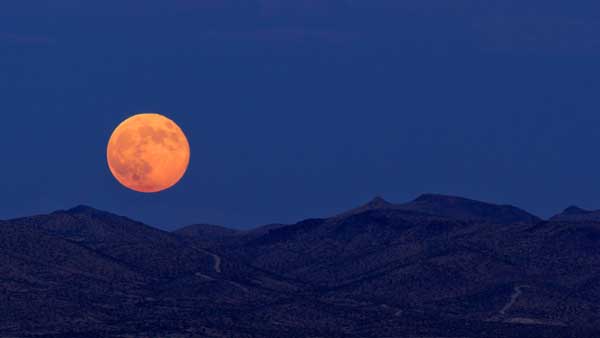A ‘supermoon’ is coming to a sky near you this weekend

Late this Sunday evening and into early Monday, the U.S. and much of the world will get to see a moon much bigger and brighter than usual before it is engulfed by a total lunar eclipse. Since this particular lunar alignment is happening for the first time in 30 years and won’t happen again until 2033, the News and Media Relations office asked Furman physics professor David Moffett what we might expect to see Sunday night.
Dr. Moffett is Furman’s astronomer and oversees the operation of the Timmons Planetarium. He teaches introductory physics courses, astronomy and mechanics, and serves as the dual-degree advisor in engineering. He also collaborates with faculty from the University of North Carolina at Chapel Hill to host the annual Educational Research in Radio Astronomy workshop at the National Radio Astronomy Observatory in Greenbank, West Virginia.
Dr. Moffett and the Furman Astronomy Club will host a viewing opportunity for the lunar event Sunday night on campus.
What exactly will be happening in the skies on Sunday night, and how unusual is this lunar event?
On Sunday, September 27, people in Greenville and most of the Western Hemisphere will have a chance to witness a lunar eclipse. Lunar eclipses occur when the Moon passes through the Earth’s shadow during Full Moon. While lunar eclipses aren’t especially rare, this one has a couple of unusual characteristics. First, the Moon will be at its closest approach in its elliptical orbit around the Earth (perigee), making this a ‘supermoon’ lunar eclipse! A supermoon can be up 14% larger in diameter than a Full Moon that occurs when it is at its farthest point in its orbit (apogee). Second, this lunar eclipse follows directly after a solar eclipse that occurred earlier on September 13 that was visible only in South Africa and Antarctica. The lunar eclipse on Sunday will be the last of a rare sequence of four lunar and solar eclipses, a ’tetrad’, that have occurred every six months since April 2014. After this one, the next total lunar eclipse observable anywhere won’t occur again until 2018; the next supermoon eclipse won’t occur until 2032.
Is the Greenville area a good place to see the lunar eclipse?
Sure. Anyone on the night-time side of the Earth when the eclipse occurs can see the event. This includes the Americas, but not Europe and Asia. Expect the darkest part of Earth’s shadow, the umbra, to cover the Moon around 9:07 PM EDT. The total eclipse will begin around 10:11 PM EDT; the mid-eclipse will occur at 10:47 PM; totality will end around 11:23 PM. The partial shadow will exit around 12:27 AM EDT. If the weather permits, this will be an ideal time for everyone to watch this event, which you can safely observe, with or without the aid of a telescope or binoculars, from any location.
Finally, the most striking part of an eclipse will be color of the Moon during totality. Once fully immersed in Earth’s shadow, the surface of the Moon will appear red! The color is the same that the Sun and sky have at sunrise or sunset. If you were standing on the Moon, as the Earth passes in front of the Sun, it will appear like sunrise or sunset, but from every horizon the Earth will appear to have a red ring of light surrounding it. Why red? When sunlight passes through the Earth’s atmosphere close to the horizon, the air behaves like a lens, bending redder colors along the horizon toward the direction of the Moon.
Is Furman planning a viewing for this event?
Yes. The Furman Astronomy Club is hosting a viewing opportunity in the Townes Science Center Courtyard, located between Plyler Hall and Riley Hall. If the skies are clear enough, we will have telescopes set up in the courtyard for viewing the eclipse. In case of inclement weather, we will stream the eclipse from an online telescope (for example, the SLOOH telescope network, slooh.com) in the Timmons Planetarium, located in Rinker Hall 253. Everyone is welcome to watch the event. We will host visitors from 8:30 PM to midnight.